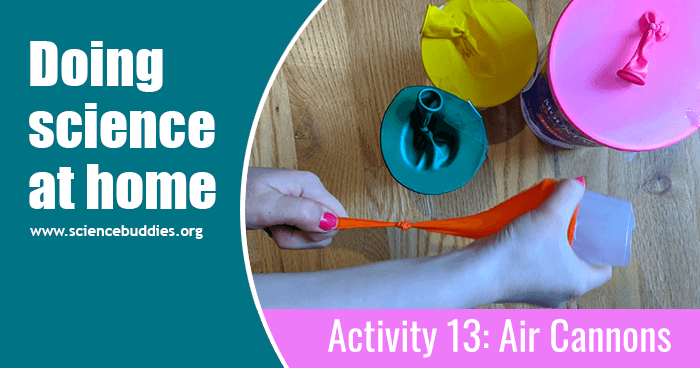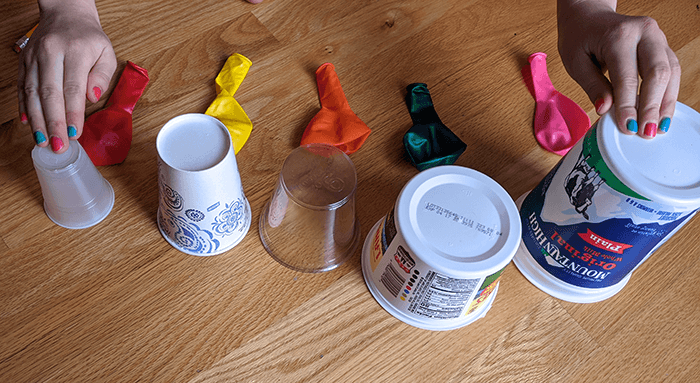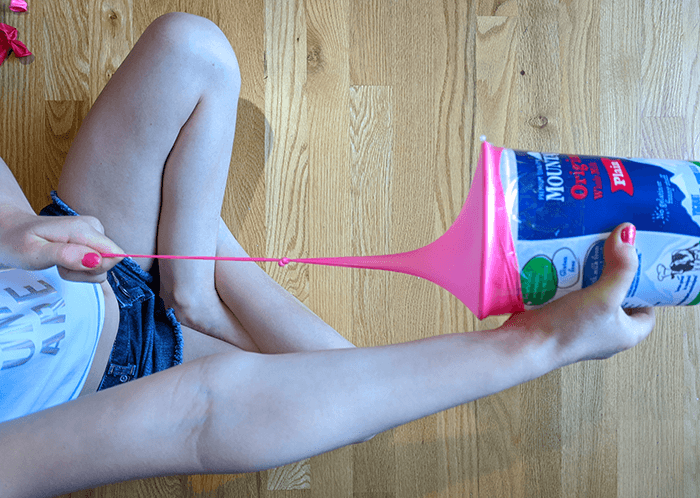Just Because She Wanted To: Doing Fun Science at Home during School Closures (Activity #13)
Follow along with a Science Buddies parent who is using family STEM activities to keep her kids learning at home during the COVID-19 school shutdown. New posts every Monday, Wednesday, and Friday. Today's adventure... building and playing with air cannons.

Letting My Child Lead the Way
Have I mentioned that I'm a bit of an obsessive planner? That hasn't been working out so well for me lately. We've had to throw away the plan a number of times. So, I tried a new approach: I let my second-grader pick our science activity today. That's right I, the control-freak mom, told her to go browse the STEM Activities library and choose. She literally spent thirty-minutes clicking through and picking out ones she wanted to try. Call it whatever you want, student-led learning, unschooling, the Montessori method, etc., I'm labeling it necessity. A kid who is getting what they want is (fingers-crossed) a kid that is happy and a little more likely to be patient about the things they don't get to control! Which is a lot these days.
If you're curious, here were her picks:
- Build A Vortex Cannon!: turn a cup into an air-blasting cannon.
- How to Make Slime: oozy, gooey slime is a kid-favorite and experimenting with altering the recipe leads to lots of fun.
- Build a Rubber Band-Powered Car: build some wheels, a car-body, and power it all with a few rubber bands.
- Build a Paper Roller Coaster: it's amazing what kinds of wild marble rides you can make out of just paper and tape.
- Elephant Toothpaste: this fizzing and foaming reaction is good messy fun, especially for younger kids.
My son was busy when all this was going on, but he'll be making his list soon, too. I'm sure you'll see all of their picks on this blog in coming weeks!
My Pick of the Day: Building Air Cannons
Practical matters like materials on hand and amount of time to devote on a given day, meant that while my daughter chose the list, I chose which one to tackle first. The winner was the Build A Vortex Cannon! activity.
Note: A vortex is a swirling pattern of fluid. While in every-day language we use "fluid" to mean a liquid; in scientific terms, a fluid is any liquid or gas. Examples of vortexes include tornados, whirlpools, and smoke rings. To simplify, I'll refer to what we made as an air cannon in this post, but vortex cannon is more accurate as the device blasts out swirling rings of air.
No surprise, the cool video was one of the things that drew my daughter to this activity.
We had three plastic cup options, of various sizes, but none of them were really large like the one in the video. My daughter was eager to try a "big" air cannon though, so we went back to our treasure chest (i.e., our recycle bin) and fished out two plastic tubs: an 8 oz one and a 32 oz one. Sure, the instructions call for cups but this is an experiment — try whatever you want and have on hand!
We decided to move forward with all five containers and made some guesses (aka hypothesis) as to which would make the strongest air cannon.

After a quick lesson on what the diameter of a circle is, my second-grader was able to measure and draw the circles on all five of our containers. Cutting them out required a bit of parental assistance though. For most of them, scissors worked, but we did have to break out the craft knife for the plastic tubs.

To make the air cannon, you blow up the balloon and then deflate it again just to stretch out the latex so that it is easier to pull across the wide opening of the cup/container. Of course, my daughter's version of this task was to blow up the balloon, a new skill of hers, and then let it go so that it flew all around the room!

Next came tying the open end of the balloons, snipping off the opposite end, and stretching a balloon over the wide opening of each cup/container. Getting the balloon to stretch that far was a challenge on our two plastic containers, but if I held the container steady (or if she used her feet to hold it steady) — my second-grader was able to pull the balloon across all of the containers except for one. The 8 oz tub eluded us. It was both wide and very flexible, unlike the stiffer plastic of the 32 oz tub, and that combination made getting a balloon on it impossible.
A bit of taping around the edges of the balloons, and the air cannons were ready to play with! While we did try them out on hanging toilet paper as shown in the activity directions, they got much more use when aimed at people. My daughter even found it funny to aim the air puffs at herself!

This was a pretty quick build. It took us less than 45 minutes to make our four air cannons. As my daughter predicted, the 32 oz container did make the most powerful air cannon. Surprisingly though, the tiny plastic Dixie cup was a close second. It had so much "extra" balloon that it pushed the air out with a lot of force, allowing the puff to travel pretty far.
My son, who had been working on a school project during this build, saw the air cannons later and asked if they could be used as confetti cannons. We agreed to try, with the caveat that he'd have to clean up after, and the answer was a resounding "yes." If you're brave enough to take on the mess, then my son's recommendation is to use crepe paper (aka tissue paper) as it flies farther than printer paper. And no, we did not try glitter — even "but mom, it's an experiment" won't convince me to allow that!
Tip: If my son's glitter idea sounds exciting to your kids, too, then you have to at least watch this fun video. It will definitely give them a boost of glitter engineering inspiration for the day!
If your kids make air cannons, confetti cannons, or explore an activity of their choice from the Science Buddies STEM activity library, post a picture of their experiment on social media and tag us. You can find us on Twitter, Facebook, and Instagram.
If this blog post was useful to you, please share it with other parents. Follow the links below to see what other science adventures we've been having at home.
View All Posts in this Series
- Activity 1 - Getting Started and Hand Washing
- Activity 2 - Taking Flight with Kites
- Activity 3 - Candle Seesaw and Fire Science
- Activity 4 - Dissecting Flowers
- Activity 5 - Building a Toy Parachute
- Activity 6 - Paper Marbling
- Activity 7 - Shaping Hard-boiled Eggs
- Activity 8 - Invisible Ink
- Activity 9 - Robot Hand
- Activity 10 - Plastic Egg Rockets
- Activity 11 - Rubber Band Guitar
- Activity 12 - Making Model Viruses
- Activity 13 - Air Cannons
- Activity 14 - Balancing an Art Mobile
- Activity 15 - Gumdrop Geometry
- Activity 16 - Solar Updraft Tower
- Activity 17 - Cotton Ball Launcher
- Activity 18 - Wire Water Striders
- Activity 19 - Ice Cream in a Bag
- Activity 20 - Wind-powered Sail Cars
- Activity 21 - Curling Metal
- Activity 22 - Popsicle Stick Catapult
- Activity 23 - Candy Diffusion
- Activity 24 - STEM Videos
- Activity 25 - Making Slime
- Activity 26 - Straw Siphon
- Activity 27 - Elephant Toothpaste
- Activity 28 - Balloon Hovercraft
- Activity 29 - Aluminum Foil Boats
- Activity 30 - Wall Marble Run
A science activity log is available as a Word document or as a Google doc for online convenience. (Just choose "File/Make a copy" to save it to your Google Drive.)
About the Author
Sandra, Science Buddies' Vice President of STEM education, holds a PhD in Genetics from Stanford University and has spent the last twelve years working on science education and STEM outreach. Right now, she's stuck working from her home in the Pacific Northwest with her husband, second grader, middle schooler, and two oddly noisy gerbils. She hypothesizes her sanity will hold as long as she gets a daily dose of sunshine.
Categories:
You Might Also Enjoy These Related Posts:
- Wall Marble Run: Doing Fun Science at Home during School Closures (Activity #30)
- Aluminum Foil Boats: Doing Fun Science at Home during School Closures (Activity #29)
- Hovercraft: Doing Fun Science at Home during School Closures (Activity #28)
- Elephant Toothpaste: Doing Fun Science at Home during School Closures (Activity #27)
- Straw Siphon: Doing Fun Science at Home during School Closures (Activity #26)
- Slime Three Ways: Doing Fun Science at Home during School Closures (Activity #25)
- A STEM Videos Breather: Doing Fun Science at Home during School Closures (Activity #24)
- Candy Experiments: Doing Fun Science at Home during School Closures (Activity #23)










